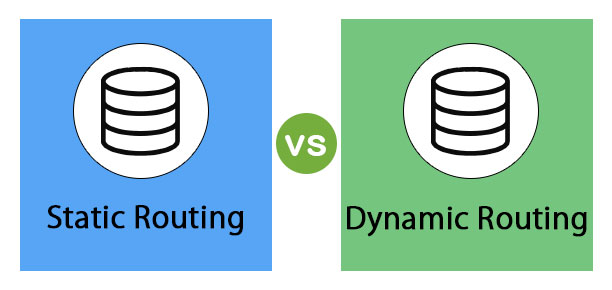Updated May 30, 2023

Difference Between Static Routing and Dynamic Routing
Routers are used to transfer the data from one location to another to forward data from one router to another; they use the information from the table that is manually entered or the information from the table that is calculated based on the routing information. In this article, we will discuss static routing vs dynamic routing in detail.
What is Static Routing?
In static routing, the routes show the path between two routers that cannot be updated automatically. The path is manually updated. If the changes occur on the network side, we need to update the routing table’s changing path. Routing tables are the tables that contain the routing information. Static routing is easy to design and implement, as there is not a complex path. Static routing is the best choice when the number of routers is less as it requires manual updates. Static routing is also known for non-adaptive routing as it does not adopt the routing path automatically.
What is Dynamic Routing?
In dynamic routing, the routers show the path between two routers that can be updated automatically. Paths are automatically updated. If the changes occur on the network side, there is no need to update the routing path manually; routing paths will automatically be updated. Paths between routers are known as routing paths. When changes occur at the network, it sends messages to a router to inform about changes. The router updates the changes and using routing algorithm routes, i.e. routing paths are calculated and updated in the table. Dynamic routing also is known for adaptive routing as it adopts the routing path automatically.
The routes or paths on which the dynamic routing is performed are known as a dynamic path or dynamic routes.in this routing; the information is responsive to the network changes to updated the changes dynamically. Responsive means it changes according to the network changes. It adjusts itself with respect to the network changes.
Head to Head Comparison between Static Routing and Dynamic Routing (Infographics)
Below are the top 10 differences between Static Routing vs Dynamic Routing
Key Differences between Static Routing and Dynamic routing
Let us discuss some of the major key differences:
- In static routing, routing tables are manually updated, while in dynamic routing, tables are automatically updated.
- The static routing is best for small network implementation and star topologies. It is not as good for any other topologies. Whereas dynamic routing is best for a large network implementation. it is good for network topologies that consist of redundant links.
- Static Routing requires less bandwidth than dynamic routing, where dynamic routing requires large bandwidth.
- In static routing routes, the path is updated by the user or an administrator, while in dynamic routing, routes are updated automatically.
- Static Routing does not use any routing protocols and algorithms, while dynamic routing uses routing protocols and complex algorithms to calculate routing operations.
- Static Routing is known for non-adaptive routing, while dynamic routing is known for adaptive routing.
- Static routes require a small administrative distance than the dynamic route.
- In static routing, routes not react with network changes, while in dynamic routing, routes react with network changes.
- Static Routing does not require a license, while dynamic routing requires a license. Also, in static routing, link failure disturbs routing is in process. While in dynamic routing, link failure does not disturb routing is in process.
- In static routing, routes for the destination are the same as defined. While in dynamic routing, routes depend on the current network topology.
- Reroute traffic is not present in static routing, while it is present in dynamic routing.
- There is no need for extra sources in static routing, while in dynamic routing, extra resources are required.
- In static routing, the network infrastructure is small, whereas network infrastructure is huge in dynamic routing.
Static Routing vs Dynamic Routing Comparison Table
Let’s discuss the top comparison between Static Routing vs Dynamic Routing.
|
Basis of Comparison |
Static Routing |
Dynamic Routing |
| Configuration Technique | In static routing, routing tables are manually updated. | In dynamic routing, routing tables are dynamically updated. |
| Bandwidth | It requires less bandwidth than dynamic routing. | It requires more bandwidth than static routing. |
| Paths/Routes | Paths are defined by administrative. | Paths are updated according to the changes in the network. |
| Application Area | Static Routing is implemented in a small network. | Dynamic Routing is implemented in a large network. |
| Routing Protocols | It does not use any protocol. | It uses protocols like eigrp, arp, etc., to calculate the routing operation. |
| Routing Algorithms | It does not use any complex routing algorithms. | It uses complex routing algorithms. |
| Security | Highly secure than dynamic routing | Less secure than static routing. |
| Link Affect | If any link between routers fails, it disturbs other routing paths. | Failure of any link between routers does not affect other routing paths. |
| Network Infrastructure | Network infrastructure is small. | The network infrastructure is large. |
| Failure of Link | Link failure disturbs routing is in process. | Link failure does not disturb routing is in process. |
Recommended Articles
This is a guide to Static Routing vs Dynamic Routing. Here we discuss the key differences with infographics and comparison table. You can also go through our other suggested articles to learn more –

